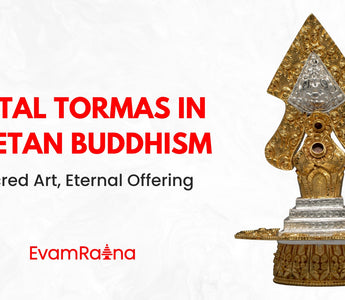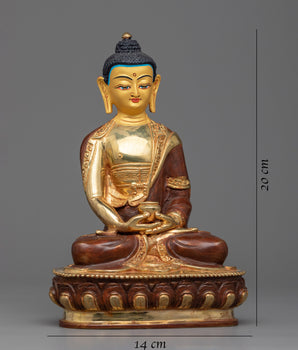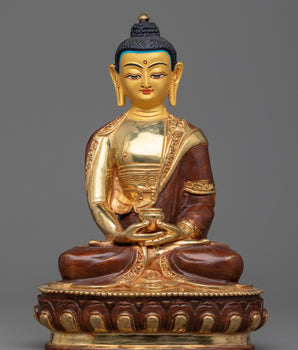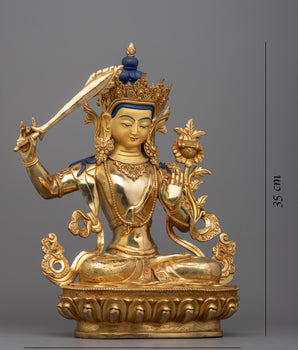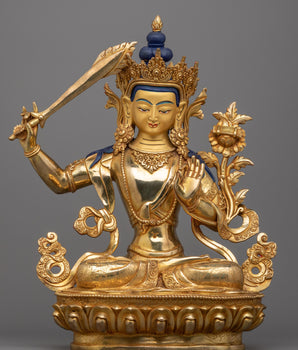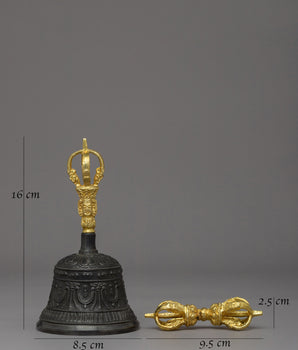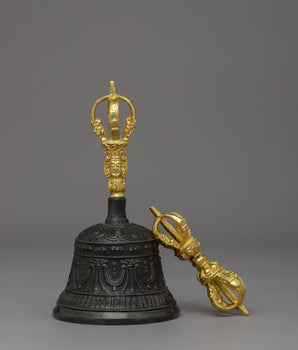Sacred Craft: Exploring the Meaning and Power of Metal Tormas in Tibetan Buddhism
The metal Torma (Tibetan: gtor ma) distinguishes itself among Tibetan Buddhist ritual items as it represents eternal devotion through its dual purpose as a physical offering and spiritual instrument. Metal alternatives differ from typical dough-based traditional forms because they serve as perpetual representations of Buddhist prayers alongside craftsmanship and cultural heritage practices. In Tibetan tradition the expression ‘torma’ represents both religious offerings and represents three essential Buddhist teachings about selflessness combined with impermanence and the Bodhisattva path. People believe that creating these sacred ritual items generates spiritual benefits which purify both mind and soul.
This blog delves into the history, symbolism, craftsmanship, and modern relevance of metal Tormas in Tibetan rituals. This complete guide will help all spiritual practitioners including art historians and cultural followers to comprehend how these sacred objects stay meaningful throughout different time periods.
The Origins and Evolution of Ritual Offerings
What Is a Torma?
The Tibetan ritual offering known as A Torma (Tibetan: gtor ma) includes barley flour and butter as its main components when used in Buddhist and Bon religious ceremonies. Religious practitioners use different shaped offerings made from barley flour and butter to honor deities and protective figures and spirits during Buddhist ceremonies as well as tantric rituals.
Traditional rice cake offerings are eaten during rituals yet metallic Torma function as enduring temple offerings which can be reintroduced during religious ceremonies. These items regularly appear in both monk-based institutions and long-lasting temples as well as tantric practices that must use fixed altar elements.

The traditional practice of these offerings connects to prayers for appeasing both Mahakala and Shri Devi, as well as other benevolent gods. In the words of his holiness, Guru Lama Zopa Rinpoche,
Tor in Tibetan is that which, when a hurricane or tornado comes, the whole city, whole town, after one hour, is totally destroyed, everywhere pieces, all the houses gone, so all the pieces are tor. Or when in a field you plant crops, you throw seeds, this is called tor. Or when you give grain, when you give food to birds, you tor, but not so much that, tor is more like the hurricane destroying a city or town, after half an hour, one hour, totally, everything is scattered. Tor is like that, something scattered or destroyed. Tor is more in the sense of destruction. So torma, that which destroys.
Historical Evolution: From Barley to Metal
The practice of ritualized food offerings in Tibet likely originated in India, referred to as Bali, although Bali included a variety of food items. As this custom travelled to the food-scarce regions of Tibet, the offering converted to be made from the integral ingredients of barley grain (Tsampa) and yak butter. Barley was already present in Bon rituals, due to this, the ritual items' origins are believed to trace back to both Buddhist and the Bon traditions.
While many Tormas are ephemeral and meant to be consumed or disposed of, metal alternatives are permanent, crafted for longevity and ritual reuse. They are especially common in monasteries, long-term shrines, and tantric practices that require stable altar components.
All Tormas during their initial development followed the Buddhist concept of impermanence by being biodegradable items. The developments of Tibetan art alongside the formalization of monastic traditions resulted in metal alternatives becoming established sacred objects. Metal ritual offerings started their appearance in the 14th century before they achieved higher levels of sophistication throughout the following centuries.
As a symbolic object the Torma evolved to showcase its multifunctional nature. Food offerings now serve two functions because they enable residents to perform spiritual rituals and execute deity manifestations and secretive instructions and preserve them for memory. Metal Tormas represent both the enhancement of spiritual duty and the need to protect sacred energy so the ritual offering can be used multiple times.
The Symbolic Power of Metal Tormas
What Makes Metal Tormas Unique?

The metal ritual object differs from traditional ones because they possess eternal qualities. The metal version maintains an eternal message about wisdom through which enlightened presence reveals itself despite following the same fashioning process as flour-based ones. Metal ritual offerings serve different rituals where they establish permanent presence in tantric retreats and protector deities as well as long-term altars.
Common Symbols Found on Metal Tormas
Esoteric symbols can be found through engraving or embossing on the majority of metal statues to boost their spiritual power. These symbols include:
-
Lotus flowers represent purity ,which grows from the world of cyclic existence known as samsara (the mud).
-
Mandala designs depict sacred images of the universal cosmos.
-
Mantras or seed syllables to invoke deities or energies.
-
Flames, vajras, and skull motifs serve rituals dedicated to wrathful protector deities.
The sacred symbols engraved on these ritual objects support the ritual functions of the offering through an appreciation of pacifying, enriching or magnetizing or wrathful powerful offerings. These artifacts function as “mnemonic devies” to help practitioners remember complex spiritual knowledge while handling them. Symbolic layers within the arrangement make the religious Torma ritual act more revered while enhancing its spiritual significance.
The Art and Craftsmanship of Metal Tormas
The production of these metal ritual objects involves a detailed artistic process while representing a tantric act. The artisans choose to work with metals that include copper, together with bronze and brass, and sometimes include silver or gold plating as well. Tibetan cosmology, along with durability, drives the selection of these metals because they align with essential sacred meanings.
Different traditional methods including hand-hammering and repoussé in combination with engraving and chasing create elaborate designs and multiple dimensions of shapes. Freehand formation exists together with molds as a means of Torma creation. Artisans insert semi-precious stones of turquoise and coral into the objects to enhance their auspicious nature.
Crafting processes include both mantra chanting and visualization methods that give sacred significance to the object being made. The manufacturing process creates a religious tool that possesses both artistic value and spiritual importance. The construction of these ritual items depends on two essential elements: proper intentions and spiritual lineal descent. Physical accomplishment, in combination with pure intentions from the artisan, forms the core principles that confirm that all tantric pursuits emanate from form-awareness unity.
The Parts of a Torma:
A traditional Torma either made of dough or metal possesses various meaningful symbolic parts that build understanding of its spiritual role. Examining the individual parts of the object enables deeper comprehension regarding its sacred use in religious rituals.
-
Base (gzhi): The base section of Torma symbolizes spiritual foundation which stands as the foundation of the path toward enlightenment. These ritual objects maintain a wide and static foundation which signifies both practitioner knowledge and teachings which remain steady.

-
Body (sku): The central body section usually takes a tapering or upward shape to symbolize the physical form of the deity whom the offering invokes. Religious elements or embossed deities along with flames serve to reflect the energy nature of the Torma.
-
Crown or Top (thod): The upper section of a Torma, called the Crown, represents enlightened wisdom plus signifies the achievement of spiritual enlightenment. The part representing the awakening mind (bodhicitta) appears as a flame, a jewel or a lotus bud within this section of the offering. The top section holds a deity symbol represented by a picture at the summit. Dieties may also be represented by the color of the offering e.g, a red-colored torma serves as an offering to Mahakala along with Shri Devi, who are fearsome protector dieties.

-
Adornments and Offerings: The side ornaments of Tormas may include flowers and skulls along with crescent moons and different presentations. Different decorative elements on ritual object symbolize both specific divine beings and particular ritual requirements. The Torma's appearance remains different between wrathful and peaceful practices where fierce imagery matches wrathful practices but peaceful ones stay decorated with symmetrical design.
-
Inscribed Mantras or Symbols: Some metal Tormas contain embedded seed syllables along with deity mantras as well as symbolic motifs which serve both protective and blessing functions. The object often receives empowerment through purposeful placement of these components.
All these components merge into a complex multidimensional artifact because they unite the tantric path's form, energetic aspects, and wisdom aspects.
The Role of Metal Tormas in Ritual Practice
Through both ritual process and intentional action, Vajrayana Buddhism makes offerings become true spiritual agents. Metal Tormas serve as physical representations of devotion and receptacles for spiritual blessings. Ritual offerings usually go to wisdom deities such as Manjushri and Tara, as well as wrathful protector,s including Vajrakilaya and Mahakal,a and guardian spirits, together with local deities. The spiritual energy accumulation capability of non-degradable metal alternatives is widely believed to be a characteristic feature. Successful ceremonies that use these sacred artifacts make them progressively more powerful with each repeating ritual. Many monasteries hold dynamic metal offerings dedicated to specific deities and rituals, making them accessible on shrine altars for annual use except during grand ceremonies when they must be removed. These ritual offerings earn elevated status because high lamas frequently bless them and show them the highest level of respect. The religious objects provide a space for holding divine energy because they function in a similar way to Ghau amulets and tsa-tsas.
Personal Use: How Practitioners Engage with Metal Tormas
When used by householders and lay practitioners, a metal ritual object serves as the central point of their home altar. People use it as their religious center to perform both prayers and daily sacrifices when they want to meditate. Sitting directly in front of the shrine, this ritual object receives support from butter lamps and incense, sacred texts, and photographs of the spiritual teacher.
Religious practitioners direct their attention towards the ritual object during mantra recitation and deity visualization prayers to enhance concentration stability and deepen their spiritual connection and generate spiritual merit. Through this practice the ritual object functions as a meditative tool which links inner practice with external ritual activities.
The Emotional and Spiritual Impact of Metal Tormas
Beyond their function, metal Tormas hold deep emotional meaning for many practitioners. Practitioners obtain these metal ritual objects as both educational gifts from teachers and family transmission objects going back through several generations of a family. Metal alternatives accumulate both spiritual and personal value after their use during important ceremonies, including retreats along with empowerments and funerals.

This ritual object portray the spiritual transformation of those who use them. Through its transformation from pure metal into a holy object the practitioner experiences a personal mental change from selfish mind states to transcendent wisdom. These ritual items serves as an essential symbol because it shows how spiritual work takes place externally as it happens internally on the path to enlightenment.
Caring for a Metal Torma
A believer must honor these objects because they hold the status of sacred ceremonial objects by providing them with complete veneration and proper maintenance. Their long-lasting significance derives not only from their materials but because of how humans keep these objects holy. A proper placement for this ritual object exists at clean elevated spots like shrines or altars where it remains protected from unpleasant surrounding elements.
By using a soft cloth to dust regularly and keeping the ritual offering underneath a protective cover between usages the item can preserve its state. Cultivating respectful thoughts about this sacred artifact conveyed through the deity or offering system is the most crucial aspect for the person keeping or working with the Torma.
According to Tibetan Buddhist teachings intention stands at the core of their religious practices. The procedure for cleaning and handling a Torma needs to be performed with devotion and mindfulness while recitations and visualizations serve as additional steps. Such practice methods strengthen personal devotion towards its central subject.
The Gold Standard in Ritual Art: Metal Tormas from Evamratna
For obtaining a metal Torma three central factors should be taken into consideration: authenticity, skilled craftsmanship, and spiritual purity. Evamratna has achieved trusted status by its dedication to traditional craftsmanship through partnerships with lineage-held artisans while consistently delivering pieces which possess museum standards of quality along with religious power.
Evamratna executes selective ritual item production, which verifies both their religious function and their sacred illustrations. Tormas represent authentic instruments enabling tantric practice rather than ornamental objects since they emerge from sacred traditions of creation.
Evamratna's website includes comprehensive background information about its offerings, which enables practitioners to make educated, purposeful purchasing decisions. These ritual offerings crafted by Evamratna serves Vajrayana Buddhist meditation purposes for both personal and religious rituals because it remains exact, strong, and filled with timeless Buddhist essence.
Click Here To View Our Exquisite Torma Collection
Final Reflections: Why Metal Tormas Endure
Metal Tormas serve as more than historical relics since they maintain their status as ever-burning components of Tibetan Buddhist ritual practice. The Vajrayana spirit lives within this ritual object which resulted from centuries of artistry and spiritual devotion. These objects unite transformational power with a reverence and wisdom union.
These ritual objects maintained by Tibetan Buddhist followers can be found throughout Himalayan monasteries and city apartment altars to lead followers toward deep states of meditative presence and ritualistic offerings. These Tibetan sacred objects inform us about the eternal nature of inner spiritual awakening which transcends external world changes.
Any tantric visualization process contains tormas by which practitioners create mandalas and deity palaces during their rituals. Regular Vajrayana practice exposes the unmatched importance of these ritual objects because practitioners need them for sacred offerings and meditation as well as transformation.
Holding or observing metal Torma objects gives one access to the unending chain of sacred visions stemming from combined devotion and sacred traditions. These objects sustain their purpose because their preservation allows us to preserve a guiding flame that enriches upcoming generations.

